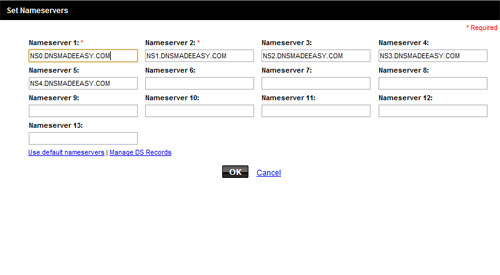
As I write this, GoDaddy just recovered from a major outage which impacted thousands of domains using their hosting service and default DNS services. While it’s easy to be angry with GoDaddy when your site goes down, this is a good opportunity to create resiliency for the future. Even if you don’t use GoDaddy, you should still pay attention to what I’m about to tell you: DNS redundancy is important.
We encourage TUNE customers to use a custom tracking domain for a variety of reasons, including maintaining a consistent brand. When you register a new domain for tracking (or anything else) the registrar applies a set of default conditions for the domain. While TUNE provides a high level of redundancy for the tracking platform, we can’t control what happens at your domain registrar.
Part of a domain registrar’s default service offering is to provide name servers that tell web surfers where they can find your domain. Name servers are a kind of living directory of where to find all the websites on the Internet, so that users don’t need to remember the IP address of your server. In fact, DNS stands for “domain name system,” a kind of phone book or rolodex for websites.
A majority of people never change the default name servers after registering a domain. You aren’t required to use your registrar’s name servers and there are some really good reasons you shouldn’t.
What Does a Domain Registrar Do?
When you register a domain with any domain registrar, whether it’s GoDaddy or some other company, they process your transaction and associate your registration with the domain name for as long as you keep renewing. Because this is a fairly commoditized service, the only way a registrar can really make any money is to offer other services, which they typically try to sell you as you are checking out.
The only thing you really need a registrar for is to act as the designated agent that can modify or delete information about your domain in a central registry database. This includes allowing you to specify the name servers that tell the rest of the internet which IP address is associated with your domain. Beyond that single core function, anything a registrar does, like offering hosting or email services, should be thought of as a separate business.
While virtually every domain registrar provides DNS services, using the registrar for both your domain registration and your DNS services creates a single point of failure.
Using a Dedicated DNS Provider
The best alternative to using name servers provided by your registrar is to use a service dedicated to DNS. These services specialize in making sure their name servers stay up and in most cases they respond more quickly to DNS requests from users than the DNS servers provided by your registrar.
At TUNE, we use Amazon’s Route 53 for DNS. It’s a highly reliable redundant service and it reduced response times for DNS calls, which means our application responds just a little bit faster when you connect to it. Route 53 is probably most widely used in conjunction with other AWS services, but could be used to direct traffic to other hosting providers as well.
For my own websites, I started using a service called DNS Made Easy several years ago, which is also used by a number of large companies. In addition to providing highly redundant DNS servers, DNS Made Easy has a great feature that makes it easy to fail over your website to another server if your primary web server goes down. That wouldn’t be necessary for a HasOffers custom tracking domain, since we handle the redundancy, but it might come in handy if you want to maintain a backup plan for your website.
Below is an example of the DNS configuration on GoDaddy with alternate DNS servers configured.

DNS Redundancy
While I have a higher degree of confidence in a dedicated DNS provider than I do in using the DNS provided by a domain registrar, using only one company is still technically a single point of failure. The way DNS works, you can very easily use two providers, so that if one were to ever go down, people would still be able to find your website.
Most registrars allow you to put at least four name servers in for redundancy. While the typical approach is to add four name servers from the same DNS provider, you can easily sign up for more than one DNS provider and use name servers from both services. This gives you a back-up plan in case one of the providers has an outage.
While I’m primarily talking about DNS redundancy in relation to a custom tracking domain, I would apply the same advice to any domain name that’s critical to your business.
What measures do you take to make sure your domains can be found?
Author
Becky is the Senior Content Marketing Manager at TUNE. Before TUNE, she led a variety of marketing and communications projects at San Francisco startups. Becky received her bachelor's degree in English from Wake Forest University. After living nearly a decade in San Francisco and Seattle, she has returned to her home of Charleston, SC, where you can find her enjoying the sun and salt water with her family.



I use a 3rd party DNS provider for my domains. But, when the main site is down It will send traffic to a mirrored site on another host or to a static page informing people the site is down.
I also love the that is my MX record times out for mail delivery it will accept all incoming mail and forward it to another mail provider so I don’t loose any e-mail.
If you are business you should really consider a DNS provider tha is not your Domain Registrar or your Hosting Company. Also, you should have your ZoneFiles mirrored at your hosting company just incase the DNS provider goes done. You can quickly update the DNS record to point to them while the DNS provider issues are resolved.
#my2cents
Thanks for this info on DNS redundancy, quite helpful.
An interesting post. My websites, issue tracker and source control were all offline recently following a power failure. I was surprised that all their DNS servers were located in a single location but after looking around this seems to be the norm.
I’m going to transfer from my current registrar anyway as their customer service is pretty poor but with I’d still have the single point of failure issue with my new one.
It hadn’t occurred to me to use a dedicated DNS service but I think it’s well worth looking into.